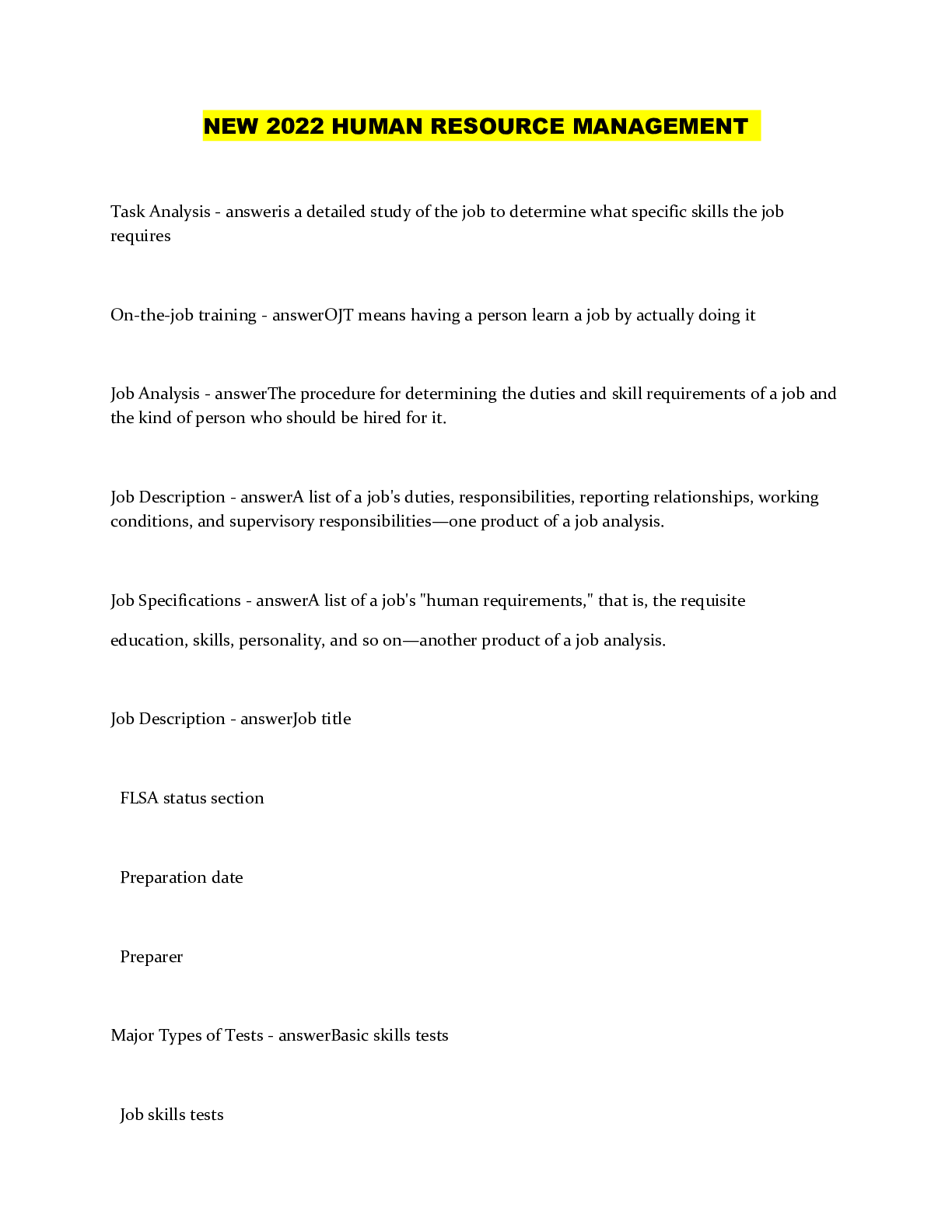Business > QUESTIONS & ANSWERS > Chapter 10 Human Resource Management and Labor Relations (All)
Chapter 10 Human Resource Management and Labor Relations
Document Content and Description Below
1 Copyright © 2017 Pearson Education, Inc. Business Essentials, 11e (Ebert/Griffin) Chapter 10 Human Resource Management and Labor Relations 1) What is another name given to human resource manage... rs? A) Financial managers B) Personnel managers C) Production managers D) Accounting managers E) Business development managers AACSB: Application of knowledge Objective: 10.1: Define human resource management, discuss its strategic significance, and explain how managers plan for their organization's human resource needs. 2) Which of the following is considered the starting point of effective human resource management? A) External staffing B) Recruitment C) Planning D) Financing E) Compensation AACSB: Application of knowledge Objective: 10.1: Define human resource management, discuss its strategic significance, and explain how managers plan for their organization's human resource needs. 3) What is the purpose of a skills inventory? A) To plan and identify people for transfer or promotion B) To list key managerial positions C) To describe the specifications for a job D) To assess trends in previous human resource usage E) To hire people from outside the organization AACSB: Application of knowledge Objective: 10.1: Define human resource management, discuss its strategic significance, and explain how managers plan for their organization's human resource needs. 2 Copyright © 2017 Pearson Education, Inc. 4) Which of the following outlines the duties of a job, its working conditions, and the tools, materials, and equipment used to perform it? A) Job advertisement B) Job specification C) Job description D) Job analysis E) Job report AACSB: Application of knowledge Objective: 10.1: Define human resource management, discuss its strategic significance, and explain how managers plan for their organization's human resource needs. 5) Which of the following describes the skills, abilities, and qualifications required for a job? A) Staffing survey B) Advertising write up C) Job specification D) Employee analysis E) Replacement chart AACSB: Application of knowledge Objective: 10.1: Define human resource management, discuss its strategic significance, and explain how managers plan for their organization's human resource needs. 6) Which of the following contains information on each employee's education, skills, work experiences, and career aspirations? A) Managerial grid B) Employee information system C) Job analysis D) Job specification E) Labor forecast Difficulty: Easy AACSB: Application of knowledge Objective: 10.1: Define human resource management, discuss its strategic significance, and explain how managers plan for their organization's human resource needs. 3 Copyright © 2017 Pearson Education, Inc. 7) Which of the following describes an organization's investment in attracting and motivating an effective workforce? A) Human capital B) Talent management C) HR planning D) Internal forecasting E) Job descriptions AACSB: Application of knowledge Objective: 10.1: Define human resource management, discuss its strategic significance, and explain how managers plan for their organization's human resource needs. 8) Where can a manager find information on the skills, abilities and other qualifications needed to perform a job successfully? A) Talent management files B) Job specification C) Human capital systems D) Job analysis E) Job description AACSB: Application of knowledge Objective: 10.1: Define human resource management, discuss its strategic significance, and explain how managers plan for their organization's human resource needs. 9) What is the systematic study of jobs within an organization? A) Talent management B) Job specification C) Human capital systems D) Job analysis E) Job description AACSB: Application of knowledge Objective: 10.1: Define human resource management, discuss its strategic significance, and explain how managers plan for their organization's human resource needs. 4 Copyright © 2017 Pearson Education, Inc. 10) Which of the following indicates an understanding of the skills employees hold and how to best use those skills for the success of the organization? A) Job analysis B) Talent management C) Skills inventory D) Adverse impact E) Human capital AACSB: Application of knowledge Objective: 10.1: Define human resource management, discuss its strategic significance, and explain how managers plan for their organization's human resource needs. 11) Job analysis is the systematic analysis of jobs within an organization resulting in a job description. AACSB: Application of knowledge Objective: 10.1: Define human resource management, discuss its strategic significance, and explain how managers plan for their organization's human resource needs. 12) Human capital represents the set of organizational activities directed at attracting, developing, and maintaining an effective workforce. AACSB: Application of knowledge Objective: 10.1: Define human resource management, discuss its strategic significance, and explain how managers plan for their organization's human resource needs. 13) A systematic study of jobs within an organization is conducted through a job analysis. AACSB: Application of knowledge Objective: 10.1: Define human resource management, discuss its strategic significance, and explain how managers plan for their organization's human resource needs. 5 Copyright © 2017 Pearson Education, Inc. 14) Replacement charts can be used to forecast the external supply of candidates for senior managerial positions in the organization. AACSB: Application of knowledge Objective: 10.1: Define human resource management, discuss its strategic significance, and explain how managers plan for their organization's human resource needs. 15) Talent management reflects the organization's investment in attracting and motivating an effective workforce. AACSB: Application of knowledge Objective: 10.1: Define human resource management, discuss its strategic significance, and explain how managers plan for their organization's human resource needs. 16) How do human resource managers use job analysis for human resource planning? AACSB: Analytical thinking Objective: 10.1: Define human resource management, discuss its strategic significance, and explain how managers plan for their organization's human resource needs. 6 Copyright © 2017 Pearson Education, Inc. 17) Discuss the strategic importance of human resources within an organization. AACSB: Analytical thinking Objective: 10.1: Define human resource management, discuss its strategic significance, and explain how managers plan for their organization's human resource needs. 18) Identify the difference between a job description and a job specification and explain how they each support the job analysis process. AACSB: Analytical thinking Objective: 10.1: Define human resource management, discuss its strategic significance, and explain how managers plan for their organization's human resource needs. 19) Which legal concept holds that both employer and employee have the mutual right to terminate an employment relationship any time, for any reason, and without advance notice to the other? A) Quid pro quo B) Affirmative action C) Employment at will D) Mutual consent E) Equal employment opportunity AACSB: Application of knowledge Objective: 10.2: Discuss the legal context of human resource management and identify contemporary legal issues. 7 Copyright © 2017 Pearson Education, Inc. 20) Which of the following constitutes an illegal hiring practice? A) Asking someone about their availability because the position requires a 50-hour work week B) Establishing a diversity committee to help diverse employees connect with each other C) Asking a candidate whether or not he attends church, because it is important that candidates are available to work on Saturdays and Sundays D) Keeping track of how many males and females are in the organization E) Requiring an applicant to specify gender on an application AACSB: Application of knowledge Objective: 10.2: Discuss the legal context of human resource management and identify contemporary legal issues. 21) Under which legal concept is it legal for a manager to discharge all her employees without advance notice? A) Quid pro quo B) Affirmative action C) Employment at will D) Joint agreement E) Arbitration AACSB: Application of knowledge Objective: 10.2: Discuss the legal context of human resource management and identify contemporary legal issues. 22) Which key piece of legislation made it illegal to discriminate in key areas of employment, including hiring, promotion, and compensation? A) Equal Employment Opportunity Act of 1972 B) Civil Rights Act of 1991 C) Equal Pay Act of 1963 D) Title VII of the Civil Rights Act of 1964 E) Fair Labor Standards ActAnswer: D Explanation: D) Title VII of the Civil Rights Act of 1964 forbids discrimination in all areas of the employment relationship, such as hiring, opportunities for advancement, compensation increases, lay-offs, and terminations against members of certain protected classes based on factors such as race, color, gender, religious beliefs, or national origin. Difficulty: Moderate AACSB: Application of knowledge Objective: 10.2: Discuss the legal context of human resource management and identify contemporary legal issues. 8 Copyright © 2017 Pearson Education, Inc. 23) Which of the following pieces of legislation made it easier to sue an employer for discrimination, but limited how much could be awarded in damages? A) Equal Employment Opportunity Act of 1972 B) Civil Rights Act of 1991 C) Equal Pay Act of 1963 D) Title VII of the Civil Rights Act of 1964 E) Fair Labor Standards Act AACSB: Application of knowledge Objective: 10.2: Discuss the legal context of human resource management and identify contemporary legal issues. 24) Which Act regulated the minimum wage and overtime payable to employees? A) ERISA B) Wagner Act C) Fair Labor Standards Act D) Taft-Hartley Act E) Civil Rights Act of 1964 AACSB: Application of knowledge Objective: 10.2: Discuss the legal context of human resource management and identify contemporary legal issues. 25) Who is charged with enforcing the provisions outlined in Title VII? A) Supreme Court B) ERISA C) OSHA D) EEOC E) NLRB AACSB: Application of knowledge Objective: 10.2: Discuss the legal context of human resource management and identify contemporary legal issues. 9 Copyright © 2017 Pearson Education, Inc. 26) Which type of plan intentionally seeks out employees from underrepresented groups within the organization? A) Civil Rights B) Adverse impact C) Employment at will D) Patriot Act E) Affirmative action AACSB: Application of knowledge Objective: 10.2: Discuss the legal context of human resource management and identify contemporary legal issues. 27) Which Act increased management rights when a union is attempting to organize a group within an organization? A) Taft-Hartley B) OSHA C) Wagner Act D) NLRA E) ERISA AACSB: Application of knowledge Objective: 10.2: Discuss the legal context of human resource management and identify contemporary legal issues. 28) How does the EEOC define sexual harassment in the workplace? A) A single off-color joke that makes a worker uncomfortable B) Any unwelcomed sexual advances C) Persistent sexual advances D) Unwelcome sexual advances made only by members of the opposite sex E) Behavior that is sexual in nature only when it is instigated by a supervisor AACSB: Application of knowledge Objective: 10.2: Discuss the legal context of human resource management and identify contemporary legal issues. 10 Copyright © 2017 Pearson Education, Inc. 29) Which of the following allows either the employer or the employee to terminate an employment relationship for any reason and at any time? A) Quid pro quo B) The National Labor Relations Act C) Employment at will D) The Patriot Act E) Taft- Hartley AACSB: Application of knowledge Objective: 10.2: Discuss the legal context of human resource management and identify contemporary legal issues. 30) What legal defense can an employer use when charged with using a pre-employment test that creates adverse impact? A) Evidence that the test identifies those who are better able to do the job than others B) Evidence that the employer sought out minorities C) Evidence that the employer treated all employees the same D) Evidence that the test included goals for underused groups E) Evidence that the test identified how hiring goals will be met AACSB: Analytical thinking Objective: 10.2: Discuss the legal context of human resource management and identify contemporary legal issues. 11 Copyright © 2017 Pearson Education, Inc. 31) Which of the following is used to identify employment goals for underused groups, and how those goals will be achieved? A) Civil rights B) Affirmative action plans C) Equal employment D) Adverse impact E) Supply and demand AACSB: Analytical thinking Objective: 10.2: Discuss the legal context of human resource management and identify contemporary legal issues. 32) When must an employer have a written affirmative action plan that details how underused groups will be pursued? A) When the employer applies for a loan B) When the employer wants to issue stock C) When the employer holds government contracts D) When the employer expands operations internationally E) When the employer is privately held AACSB: Application of knowledge Objective: 10.2: Discuss the legal context of human resource management and identify contemporary legal issues. 33) Who is defined as an older worker under the Age Discrimination in Employment Act? A) Those over 30 years of age B) Those over 40 years of age C) Those over 50 years of age D) Those over 60 years of age E) Those over 70 years of age AACSB: Application of knowledge Objective: 10.2: Discuss the legal context of human resource management and identify contemporary legal issues. 12 Copyright © 2017 Pearson Education, Inc. 34) The Age Discrimination in Employment Act requires passive nondiscrimination. How do employers practice passive nondiscrimination? A) By seeking employees who are protected by the act B) By seeking minorities who are protected by the act C) By providing special treatment to women and minorities D) By treating all who apply fairly E) By increasing salaries for workers covered by the Act AACSB: Application of knowledge Objective: 10.2: Discuss the legal context of human resource management and identify contemporary legal issues. 35) Which of the following Acts helps to ensure the financial security of pension funds? A) Employee Retirement Income Security Act B) Wagner Act C) Age Discrimination in Employment Act D) Equal Pay Act E) Fair Labor Standards Act AACSB: Application of knowledge Objective: 10.2: Discuss the legal context of human resource management and identify contemporary legal issues. 36) What is the purpose of the Family and Medical Leave Act of 1993? A) To extend the length of maternity leaves B) To allow employees to take a leave of absence with pay C) To allow employees to take a leave of absence for family or medical emergencies or when a child is born D) To increase the percentage of payroll spent on health care for workers E) To ensure financial security for all employees, regardless of circumstance AACSB: Analytical thinking Objective: 10.2: Discuss the legal context of human resource management and identify contemporary legal issues. 13 Copyright © 2017 Pearson Education, Inc. 37) Which of the following set up procedures for employees to vote on their desire for union representation? A) Taft-Hartley Act B) Labor-Management Relations Act C) Occupational Safety and Health Act D) Wagner Act E) Patriot Act AACSB: Analytical thinking Objective: 10.2: Discuss the legal context of human resource management and identify contemporary legal issues. 38) Which Act established the National Labor Relations Board? A) Taft-Hartley Act B) Patriot Act C) Labor-Management Relations Act D) Occupational Safety and Health Act E) National Labor Relations Act AACSB: Analytical thinking Objective: 10.2: Discuss the legal context of human resource management and identify contemporary legal issues. 39) Employers may require an AIDS test as a condition of an offer of employment. AACSB: Application of knowledge Objective: 10.2: Discuss the legal context of human resource management and identify contemporary legal issues. 14 Copyright © 2017 Pearson Education, Inc. 40) The Occupational Safety and Health Act of 1970 is the single most comprehensive piece of legislation regarding workplace safety and health. AACSB: Application of knowledge Objective: 10.2: Discuss the legal context of human resource management and identify contemporary legal issues. 41) In spite of employment at will, employees may not be fired for filing workers' compensation claims. AACSB: Application of knowledge Objective: 10.2: Discuss the legal context of human resource management and identify contemporary legal issues. 42) It is illegal to use any pre-employment test that creates adverse impact. AACSB: Analytical thinking Objective: 10.2: Discuss the legal context of human resource management and identify contemporary legal issues. 43) ERISA was designed to regulate how pension funds are invested. AACSB: Application of knowledge Objective: 10.2: Discuss the legal context of human resource management and identify contemporary legal issues. 44) The Family and Medical Leave Act of 1993 requires employers to provide up to 12 weeks of paid leave for family and medical emergencies or when a child is born. AACSB: Application of knowledge Objective: 10.2: Discuss the legal context of human resource management and identify contemporary legal issues. 15 Copyright © 2017 Pearson Education, Inc. 45) The National Labor relations Board was established by the Wagner Act to enforce the provisions of the Act.. Difficulty: Moderate AACSB: Application of knowledge Objective: 10.2: Discuss the legal context of human resource management and identify contemporary legal issues. 46) The Patriot Act gives Human Resource Managers access to previously confidential personal information on employees, such as health and financial records. AACSB: Application of knowledge Objective: 10.2: Discuss the legal context of human resource management and identify contemporary legal issues. 47) Explain the role of equal employment opportunity and the Equal Employment Opportunity Commission. AACSB: Analytical thinking Objective: 10.2: Discuss the legal context of human resource management and identify contemporary legal issues. 48) What are the two types of sexual harassment as defined by the courts? AACSB: Application of knowledge Objective: 10.2: Discuss the legal context of human resource management and identify contemporary legal issues. 16 Copyright © 2017 Pearson Education, Inc. 49) Describe the purpose of the Wagner Act, including how the Act is enforced. AACSB: Application of knowledge Objective: 10.2: Discuss the legal context of human resource management and identify contemporary legal issues. 50) Discuss the implications of the Patriot Act for Human Resource Management. AACSB: Analytical thinking Objective: 10.2: Discuss the legal context of human resource management and identify contemporary legal issues. 51) Which selection technique is MOST likely to introduce bias? A) Interview B) Application forms C) Aptitude tests D) Drug testing E) Polygraph tests AACSB: Application of knowledge Objective: 10.3: Identify the steps in staffing a company and discuss ways in which organizations recruit and select new employees. 17 Copyright © 2017 Pearson Education, Inc. 52) Which of the following is conducted to attract qualified persons to apply for available jobs? A) Realistic job previews B) Recruiting C) Selection D) Hiring E) Interviews AACSB: Application of knowledge Objective: 10.3: Identify the steps in staffing a company and discuss ways in which organizations recruit and select new employees. 53) What is the advantage of promoting from within when filling an opening within the organization? A) Less need for a realistic job preview B) Increased influx of high quality employees C) Increased employee morale D) Reduced turnover E) Increased diversity of employees AACSB: Application of knowledge Objective: 10.3: Identify the steps in staffing a company and discuss ways in which organizations recruit and select new employees. 54) How can a firm help to ensure a new hire has a thorough understanding of a position before accepting the position? A) Allow the candidate to job shadow for a day. B) Use team interviews comprised of employees from that department. C) Institute a higher than standard compensation system. D) Use realistic job previews. E) Use a different application form for each type of position available. AACSB: Application of knowledge Objective: 10.3: Identify the steps in staffing a company and discuss ways in which organizations recruit and select new employees. 18 Copyright © 2017 Pearson Education, Inc. 55) What is the most popular pre-employment test given? A) Drug tests B) Reference checks C) Credit checks D) Physical exams E) Interviews AACSB: Application of knowledge Objective: 10.3: Identify the steps in staffing a company and discuss ways in which organizations recruit and select new employees. 56) Human resource managers need to forecast the internal and external supply of employees. AACSB: Application of knowledge Objective: 10.3: Identify the steps in staffing a company and discuss ways in which organizations recruit and select new employees. 57) When forecasting the internal supply of labor, planners must rely on information from sources such as government reports and figures supplied by colleges on the number of students in major fields. AACSB: Application of knowledge Objective: 10.3: Identify the steps in staffing a company and discuss ways in which organizations recruit and select new employees. 58) Companies often use internal recruitment to build morale and keep high-quality employees from leaving. AACSB: Application of knowledge Objective: 10.3: Identify the steps in staffing a company and discuss ways in which organizations recruit and select new employees. 19 Copyright © 2017 Pearson Education, Inc. 59) When selecting someone to hire, the first step in selection is usually asking the candidate to take a test. Answer: FALSE Explanation: The first step is to fill out an application or send a résumé. Difficulty: Moderate AACSB: Application of knowledge Objective: 10.3: Identify the steps in staffing a company and discuss ways in which organizations recruit and select new employees. 60) Distinguish between internal and external recruiting. AACSB: Application of knowledge Objective: 10.3: Identify the steps in staffing a company and discuss ways in which organizations recruit and select new employees. 61) Describe how wages, salaries, incentives, and benefits programs help companies attract and keep skilled workers. AACSB: Application of knowledge Objective: 10.3: Identify the steps in staffing a company and discuss ways in which organizations recruit and select new employees. 62) Which of the following links salary increases to performance levels in nonsales jobs? A) Bonuses B) Collective bargaining C) Merit salary systems D) Cafeteria benefit plans E) Workers' compensation insurance AACSB: Application of knowledge Objective: 10.4: Describe the main components of a compensation and benefits system. 20 Copyright © 2017 Pearson Education, Inc. 63) When a paycheck is calculated from the number of hours worked during the week times the hourly rate, what type of system is being used to pay employees? A) Gainsharing B) Salary C) Profit sharing D) Wage E) Incentive AACSB: Application of knowledge Objective: 10.4: Describe the main components of a compensation and benefits system. 64) Which refers to compensation other than wages and salaries and other incentive pay offered by a firm to its workers? A) Profit-sharing B) Gainsharing C) Benefits D) Pay-for-knowledge E) Variable AACSB: Application of knowledge Objective: 10.4: Describe the main components of a compensation and benefits system. 65) What is the total package that a firm offers employees in return for their labor? A) Wage B) Salary C) Benefits package D) Compensation package E) Retention plan AACSB: Application of knowledge Objective: 10.4: Describe the main components of a compensation and benefits system. 21 Copyright © 2017 Pearson Education, Inc. 66) What do top executives often receive as incentives? A) Merit salary systems B) Workers' compensation insurance C) Salaries D) Stock options E) Wages AACSB: Application of knowledge Objective: 10.4: Describe the main components of a compensation and benefits system. 67) What type of pay system rewards middle managers for especially high output, often exceeding the value of bonuses? A) Variable pay B) Merit raises C) Profit-sharing D) Gainsharing E) Pay-for-knowledge AACSB: Application of knowledge Objective: 10.4: Describe the main components of a compensation and benefits system. 68) Which of the following is considered to be more effective than merit raises in motivating middle managers to increase output? A) Wage inflation B) A bonus system C) A gainsharing plan D) Pay for performance E) Salary sacrifice AACSB: Application of knowledge Objective: 10.4: Describe the main components of a compensation and benefits system. 22 Copyright © 2017 Pearson Education, Inc. 69) If a firm ends its fiscal year with profit, which plan can the firm use to distribute part of the excess to employees? A) Gainsharing plan B) Profit-sharing plan C) Cafeteria plan D) Insurance plan E) Salary-sharing plan AACSB: Analytical thinking Objective: 10.4: Describe the main components of a compensation and benefits system. 70) Which of the following companywide incentive plans distribute bonuses to employees when a company's costs are reduced through greater work efficiency? A) Wage setting plans B) Pay-for-performance plans C) Profit-sharing plans D) Gainsharing plans E) Pay-for-knowledge plans AACSB: Analytical thinking Objective: 10.4: Describe the main components of a compensation and benefits system. 71) Some employers provide employees with a fixed dollar amount for benefits, allowing employees to choose between various health insurance, life insurance, disability insurance, and educational benefits. What is the name of this plan? A) Gainsharing B) Profit-sharing C) Cafeteria benefits D) Equal employment E) Retention benefits AACSB: Analytical thinking Objective: 10.4: Describe the main components of a compensation and benefits system. 23 Copyright © 2017 Pearson Education, Inc. 72) Wages refer to compensation usually expressed as an amount paid per year. AACSB: Application of knowledge Objective: 10.4: Describe the main components of a compensation and benefits system. 73) The number of variable pay programs in the United States has been consistently falling for the last decade, and it is predicted that they will continue to decline in popularity. Difficulty: Moderate AACSB: Application of knowledge Objective: 10.4: Describe the main components of a compensation and benefits system. 74) Many firms say that merit raises are a better motivator than variable pay. Difficulty: Moderate AACSB: Application of knowledge Objective: 10.4: Describe the main components of a compensation and benefits system. 75) In a company-sponsored pension plan, employees are not allowed or required to make contributions. AACSB: Application of knowledge Objective: 10.4: Describe the main components of a compensation and benefits system. 76) In recent years, some companies have run into problems because they have not set aside enough money to cover the retirement funds they have agreed to provide. AACSB: Application of knowledge Objective: 10.4: Describe the main components of a compensation and benefits system. 24 Copyright © 2017 Pearson Education, Inc. 77) In setting wage and salary levels, a firm may start by looking at competitors' levels. AACSB: Application of knowledge Objective: 10.4: Describe the main components of a compensation and benefits system. 78) Explain commonly offered benefits and identify at least two benefits that are mandated by the Federal government. AACSB: Application of knowledge Objective: 10.4: Describe the main components of a compensation and benefits system. 79) Which of the following types of training occurs while the employee is at his or her place of work? A) On-the-job training B) Vestibule training C) Off-site training D) Incentive training E) Remote training AACSB: Application of knowledge Objective: 10.5: Describe how managers develop the workforce in their organization through training and performance appraisal. 25 Copyright © 2017 Pearson Education, Inc. 80) A departmental manager is meeting with each of his subordinates to discuss their performance over the past year. What process is he involved in? A) Job description B) Labor negotiations C) Vestibule assessment D) Performance appraisal E) Financial remuneration AACSB: Application of knowledge Objective: 10.5: Describe how managers develop the workforce in their organization through training and performance appraisal. 81) When does the appraisal process begin? A) When the manager defines performance standards for an employee B) After the manager observes the employee's performance C) As soon as the employee begins working D) When the employee leaves an organization E) As soon as the employee requests direction AACSB: Analytical thinking Objective: 10.5: Describe how managers develop the workforce in their organization through training and performance appraisal. 82) A restaurant is undergoing a change in cuisine and style of service. It is important that new staff is hired and existing staff retrained. Why might the HR manager recommend vestibule training as being highly effective in this situation? A) Prospective and present employees can be screened to see if they convey the restaurant's new ethos. B) Off-site training has great value for evaluating the effectiveness of performance appraisals. C) Employees will be reluctant to undertake training removed from the workplace. D) The owners can be more confident that the change to the restaurant will be popular with customers. E) Employees will see limited connections to everyday work in this type of training. AACSB: Analytical thinking Objective: 10.5: Describe how managers develop the workforce in their organization through training and performance appraisal. 26 Copyright © 2017 Pearson Education, Inc. 83) Which of the following will help a manager be more successful both now and at some point in the future? A) Training B) Development C) Cafeteria-style plans D) Pay-for-knowledge plans E) Vestibule training AACSB: Application of knowledge Objective: 10.5: Describe how managers develop the workforce in their organization through training and performance appraisal. 84) How can an organization determine if training has been successful? A) Have employees fill out a survey on how well they liked the training. B) Track how much time employees spent at the training program. C) Monitor the waiting list for the training program. D) Test job performance both before and after training has been complete. E) Measure job performance after training has been completed. AACSB: Application of knowledge Objective: 10.5: Describe how managers develop the workforce in their organization through training and performance appraisal. 85) Which of the following is used to aid in decision making about training, raises, and promotions? A) Judgments B) Evaluation of training C) Vestibule training D) On-the-job training E) Performance appraisals AACSB: Application of knowledge Objective: 10.5: Describe how managers develop the workforce in their organization through training and performance appraisal. 27 Copyright © 2017 Pearson Education, Inc. 86) When conducting a performance appraisal that uses output as a basis for appraisal, what type of method is being used? A) Objective B) Judgmental C) Ranking D) Comparison E) Rating AACSB: Application of knowledge Objective: 10.5: Describe how managers develop the workforce in their organization through training and performance appraisal. 87) What is the advantage of using a rating method during the performance review process? A) Each employee is compared to all other employees in the group. B) Each employee is compared to a fixed standard. C) The recency error is eliminated. D) Managers do not need to utilize a 360-degree review. E) Providing employee with meaningful feedback is easier. AACSB: Application of knowledge Objective: 10.5: Describe how managers develop the workforce in their organization through training and performance appraisal. 88) What type of rating system incorporates feedback from customers, subordinates and peers, among others? A) Ranking B) Recency C) 360-degree feedback D) Judgmental E) Rating AACSB: Application of knowledge Objective: 10.5: Describe how managers develop the workforce in their organization through training and performance appraisal. 28 Copyright © 2017 Pearson Education, Inc. 89) Performance appraisals are designed to show workers how well they are doing their jobs. AACSB: Application of knowledge Objective: 10.5: Describe how managers develop the workforce in their organization through training and performance appraisal. 90) The best method of evaluating the success of training is to ask how the employees liked the training and which aspects they feel will be most relevant to their job. AACSB: Application of knowledge Objective: 10.5: Describe how managers develop the workforce in their organization through training and performance appraisal. 91) How do organizations develop workers' skills? AACSB: Application of knowledge Objective: 10.5: Describe how managers develop the workforce in their organization through training and performance appraisal. 92) What is the name given to an employee who is hired on something other than a permanent or full-time basis? A) Knowledge expert B) Contingent worker C) Technical employee D) Supervisory manager E) Managing director AACSB: Application of knowledge Objective: 10.6: Discuss workforce diversity, the management of knowledge workers, and the use of a contingent workforce as important changes in the contemporary workplace. 29 Copyright © 2017 Pearson Education, Inc. 93) Workers such as computer scientists, engineers, and software developers who typically require extensive and highly specialized training, are known as what? A) Technical workers B) Knowledge workers C) Contingent workers D) Labor relation workers E) Union workers AACSB: Application of knowledge Objective: 10.6: Discuss workforce diversity, the management of knowledge workers, and the use of a contingent workforce as important changes in the contemporary workplace. 94) Which term refers to employees hired to supplement a firm's permanent workforce? A) Union workers B) Contingent workers C) Knowledge workers D) Flextime workers E) Remote workers AACSB: Application of knowledge Objective: 10.6: Discuss workforce diversity, the management of knowledge workers, and the use of a contingent workforce as important changes in the contemporary workplace. 95) What are independent contractors, on-call workers, temporary employees, contract employees, and leased employees all examples of? A) Union workers B) Contingent workers C) Migratory workers D) Ancillary workers E) International workers AACSB: Application of knowledge Objective: 10.6: Discuss workforce diversity, the management of knowledge workers, and the use of a contingent workforce as important changes in the contemporary workplace. 30 Copyright © 2017 Pearson Education, Inc. 96) What is the advantage for a firm who works to hire from a diverse workforce? A) Greater social awareness among employees B) Increased ability to institute cafeteria-style benefits C) A higher quality labor force D) More flexibility in schedules E) Increased employee retention AACSB: Analytical thinking Objective: 10.6: Discuss workforce diversity, the management of knowledge workers, and the use of a contingent workforce as important changes in the contemporary workplace. 97) In addition to increased flexibility, why do organizations use contingent workers? A) There is less need for training. B) Contingent workers can replace knowledge workers. C) Contingent workers often represent a higher quality labor force. D) Contingent workers are less expensive to hire. E) The organization simply cannot find full time workers. AACSB: Analytical thinking Objective: 10.6: Discuss workforce diversity, the management of knowledge workers, and the use of a contingent workforce as important changes in the contemporary workplace. 98) The range of workers' attitudes, values, beliefs, and behaviors that differ based on age, gender, or ethnicity all represent workforce diversity. Difficulty: Easy AACSB: Application of knowledge Objective: 10.6: Discuss workforce diversity, the management of knowledge workers, and the use of a contingent workforce as important changes in the contemporary workplace. 31 Copyright © 2017 Pearson Education, Inc. 99) The increased demand for knowledge workers will require firms to use extra measures, such as higher salaries and signing bonuses, to attract qualified employees.. Difficulty: Moderate AACSB: Application of knowledge Objective: 10.6: Discuss workforce diversity, the management of knowledge workers, and the use of a contingent workforce as important changes in the contemporary workplace. 100) Explain the meaning of workforce diversity. AACSB: Application of knowledge Objective: 10.6: Discuss workforce diversity, the management of knowledge workers, and the use of a contingent workforce as important changes in the contemporary workplace. 101) How can diversity create competitive advantage? AACSB: Analytical thinking Objective: 10.6: Discuss workforce diversity, the management of knowledge workers, and the use of a contingent workforce as important changes in the contemporary workplace. 102) When does the collective bargaining process begin? A) When the contract is ratified by the members B) When the bargaining zone is identified C) When the union is recognized as the official bargaining agent D) When union and management representatives agree to contract terms E) When the employer establishes a maximum limit AACSB: Application of knowledge Objective: 10.7: Explain why workers organize into labor unions and describe the collective bargaining process. 32 Copyright © 2017 Pearson Education, Inc. 103) What is the name given to a group of individuals working together to achieve shared jobrelated goals such as higher pay, shorter working hours, greater benefits, or better working conditions? A) Management organization B) Company hierarchy C) Labor union D) External organization E) Permanent employees AACSB: Application of knowledge Objective: 10.7: Explain why workers organize into labor unions and describe the collective bargaining process. 104) Which term refers to a labor action in which employees temporarily walk off the job and refuse to work? A) Strike B) Lockout C) Boycott D) Mediation E) Bargaining Objective: 10.7: Explain why workers organize into labor unions and describe the collective bargaining process. 105) Who are temporary or permanent replacements for striking workers? A) Strikebreakers B) Union busters C) Union breakers D) Contingent workers E) Labor relation teams AACSB: Application of knowledge Objective: 10.7: Explain why workers organize into labor unions and describe the collective bargaining process. 33 Copyright © 2017 Pearson Education, Inc. 106) What is the process of working with employees who are represented by a union? A) Labor relations B) Human resource management C) Negotiation D) Arbitration E) Contingency recruitment AACSB: Application of knowledge Objective: 10.7: Explain why workers organize into labor unions and describe the collective bargaining process. 107) What is the process by which union leaders and managers negotiate common terms and conditions of employment for the workers represented by unions? A) Striking B) Picketing C) Informational gathering D) Collective bargaining E) Compensation planning AACSB: Application of knowledge Objective: 10.7: Explain why workers organize into labor unions and describe the collective bargaining process. 108) Which of the following occurs when union members agree NOT to buy the products of a targeted employer? A) Lockout B) Boycott C) Mediation D) Arbitration E) Slowdown AACSB: Application of knowledge Objective: 10.7: Explain why workers organize into labor unions and describe the collective bargaining process. 34 Copyright © 2017 Pearson Education, Inc. 109) If negotiations fail, what can a company choose to use to prevent union employees from coming to work? A) Wildcat strike B) Lockout C) Strikebreaker D) Economic strike E) Bailout AACSB: Application of knowledge Objective: 10.7: Explain why workers organize into labor unions and describe the collective bargaining process. 110) What occurs when a neutral third party dictates a settlement between two sides that have agreed to submit to outside judgment? A) Mediation B) Arbitration C) Strikebreaker D) Impasse E) Picketing AACSB: Application of knowledge Objective: 10.7: Explain why workers organize into labor unions and describe the collective bargaining process. 35 Copyright © 2017 Pearson Education, Inc. 111) In a union contract, future wage increases are often tied to the Consumer Price Index and provide for A) economic strikes. B) contract renegotiations. C) wage reopener clauses. D) pay tied to productivity. E) cost of living adjustments. AACSB: Application of knowledge Objective: 10.7: Explain why workers organize into labor unions and describe the collective bargaining process. 112) What tactic could a unionized employee take to show why they are striking against an employer? A) Picketing B) Boycotting C) Work slowdowns D) Mediation E) Lockouts AACSB: Analytical thinking Objective: 10.7: Explain why workers organize into labor unions and describe the collective bargaining process. 113) Which alternative to striking encourages to work at a pace that results in significantly lower productivity for the organization? A) Work slowdown B) Lock out C) Sickout D) Picket E) Boycott AACSB: Application of knowledge Objective: 10.7: Explain why workers organize into labor unions and describe the collective bargaining process. 36 Copyright © 2017 Pearson Education, Inc. 114) Labor relations refers to the dealing with employees who are not represented by a union. AACSB: Application of knowledge Objective: 10.7: Explain why workers organize into labor unions and describe the collective bargaining process. 115) A solution to a long-term contract based solely on COLA is called a wage reopener clause that does not allow wage rates to be renegotiated. AACSB: Application of knowledge Objective: 10.7: Explain why workers organize into labor unions and describe the collective bargaining process. 116) Although millions of American workers still belong to unions, union membership as a percentage of the total workforce has steadily declined. AACSB: Application of knowledge Objective: 10.7: Explain why workers organize into labor unions and describe the collective bargaining process. 117) Wage reopener clauses are not required by law. AACSB: Application of knowledge Objective: 10.7: Explain why workers organize into labor unions and describe the collective bargaining process. 118) A work slowdown is an alternative to striking where large numbers of workers perform at a much slower pace than normal. AACSB: Application of knowledge Objective: 10.7: Explain why workers organize into labor unions and describe the collective bargaining process. 37 Copyright © 2017 Pearson Education, Inc. 119) Describe the current trends in labor-management relations in the United States. Difficulty: Difficult AACSB: Application of knowledge Objective: 10.7: Explain why workers organize into labor unions and describe the collective bargaining process. 120) Explain the difference between labor relations and a labor union. AACSB: Application of knowledge Objective: 10.7: Explain why workers organize into labor unions and describe the collective bargaining process. 121) What options are available to the union when contract negotiations break down? AACSB: Application of knowledge Objective: 10.7: Explain why workers organize into labor unions and describe the collective bargaining process. 122) What options are available to management when contract negotiations break down? AACSB: Application of knowledge Objective: 10.7: Explain why workers organize into labor unions and describe the collective bargaining process. 38 Copyright © 2017 Pearson Education, Inc. 123) Why is it important for the union to include a cost-of-living adjustment clause when negotiating a union contract? AACSB: Application of knowledge Objective: 10.7: Explain why workers organize into labor unions and describe the collective bargaining process. 124) A union can picket, boycott, or use a work slowdown to support strike efforts. Why would the union choose one of these over the other? AACSB: Application of knowledge Objective: 10.7: Explain why workers organize into labor unions and describe the collective bargaining process. [Show More]
Last updated: 2 years ago
Preview 1 out of 38 pages

Buy this document to get the full access instantly
Instant Download Access after purchase
Buy NowInstant download
We Accept:

Reviews( 0 )
$5.00
Can't find what you want? Try our AI powered Search
Document information
Connected school, study & course
About the document
Uploaded On
Jan 07, 2020
Number of pages
38
Written in
Additional information
This document has been written for:
Uploaded
Jan 07, 2020
Downloads
0
Views
119

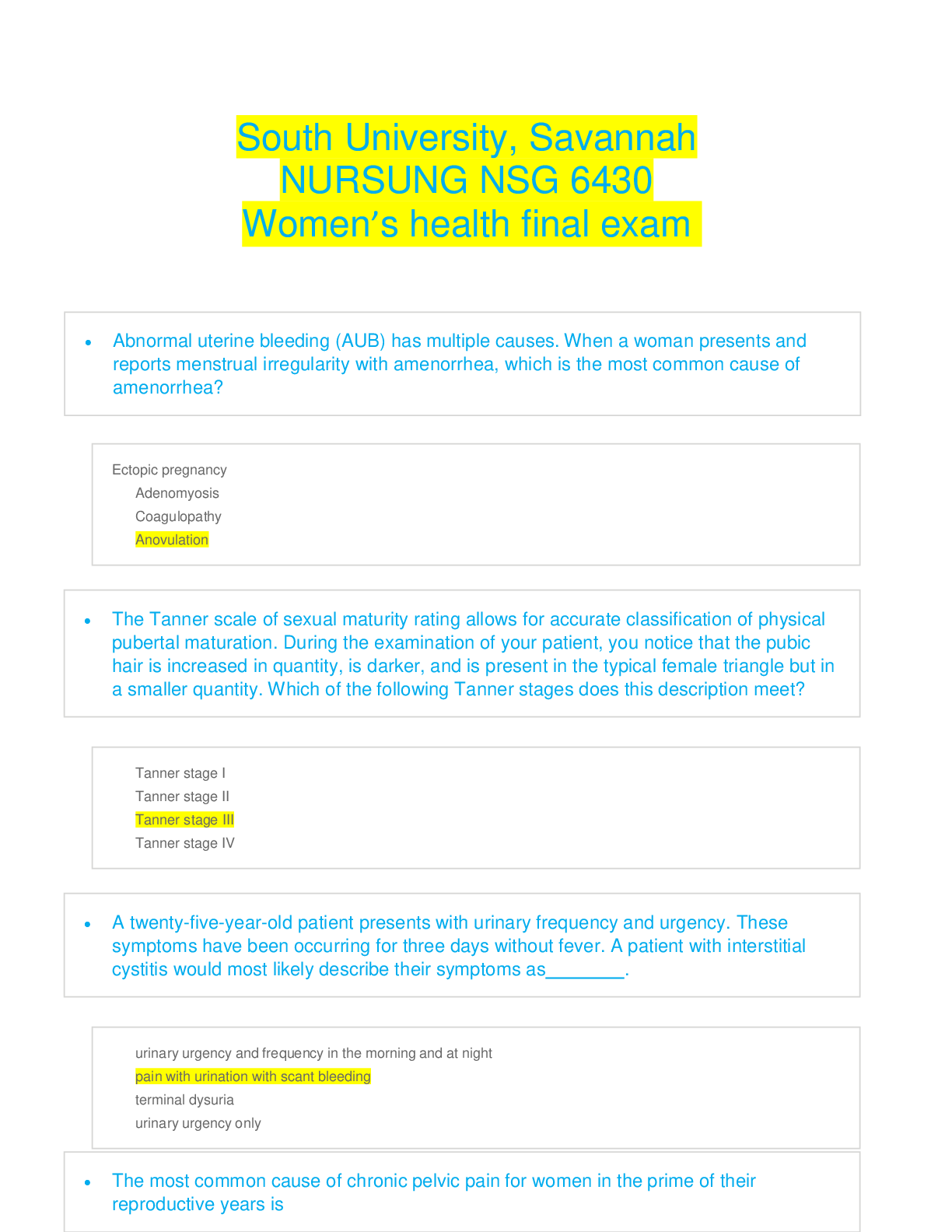

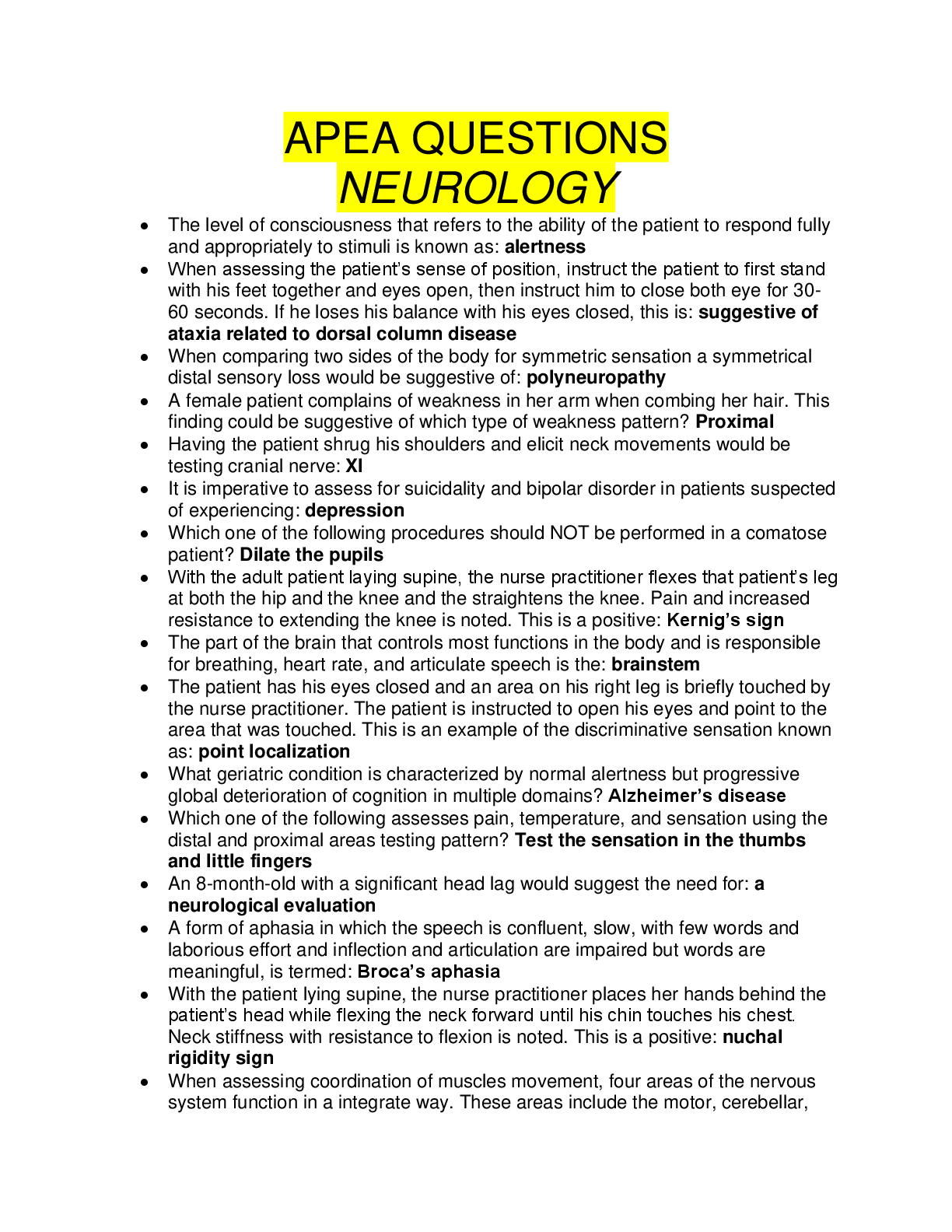

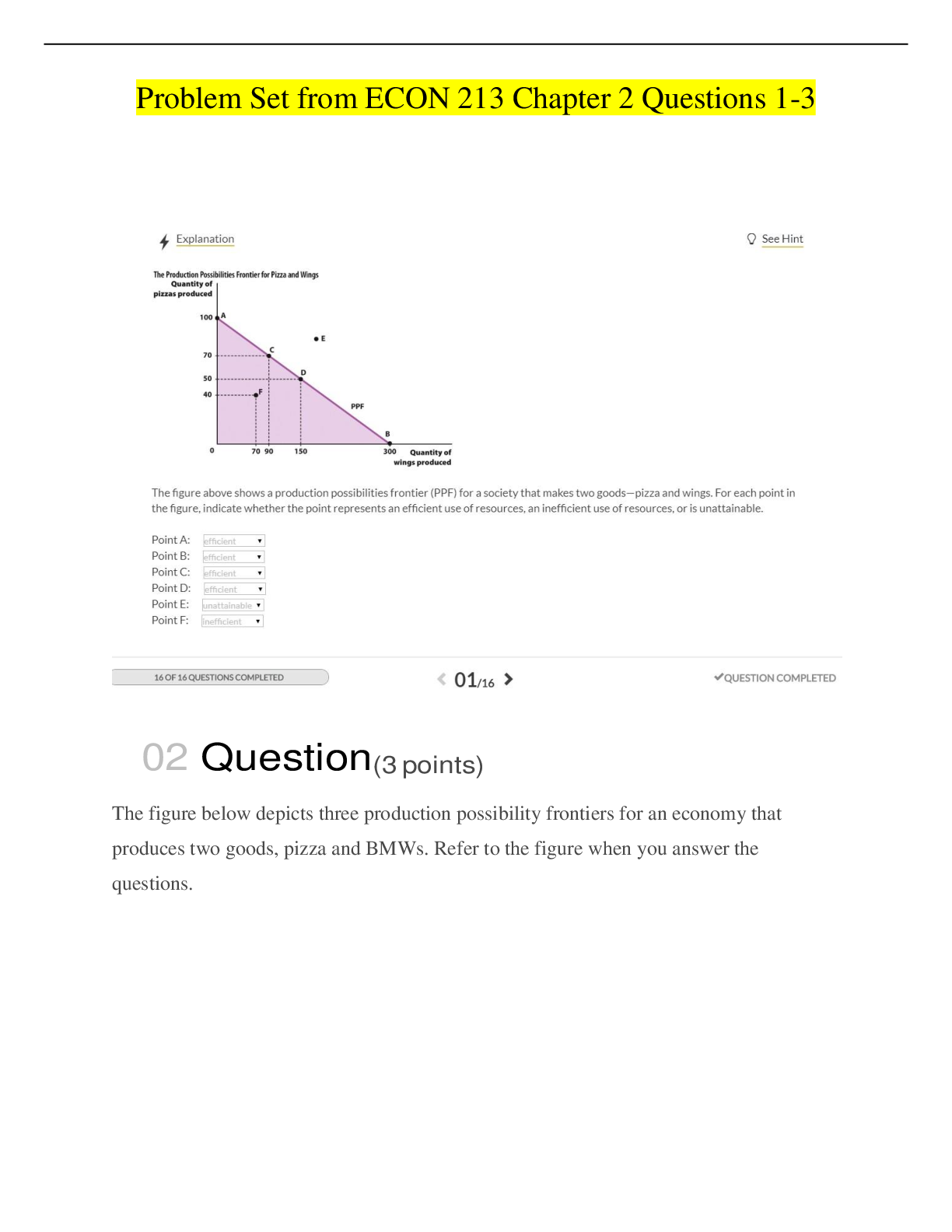
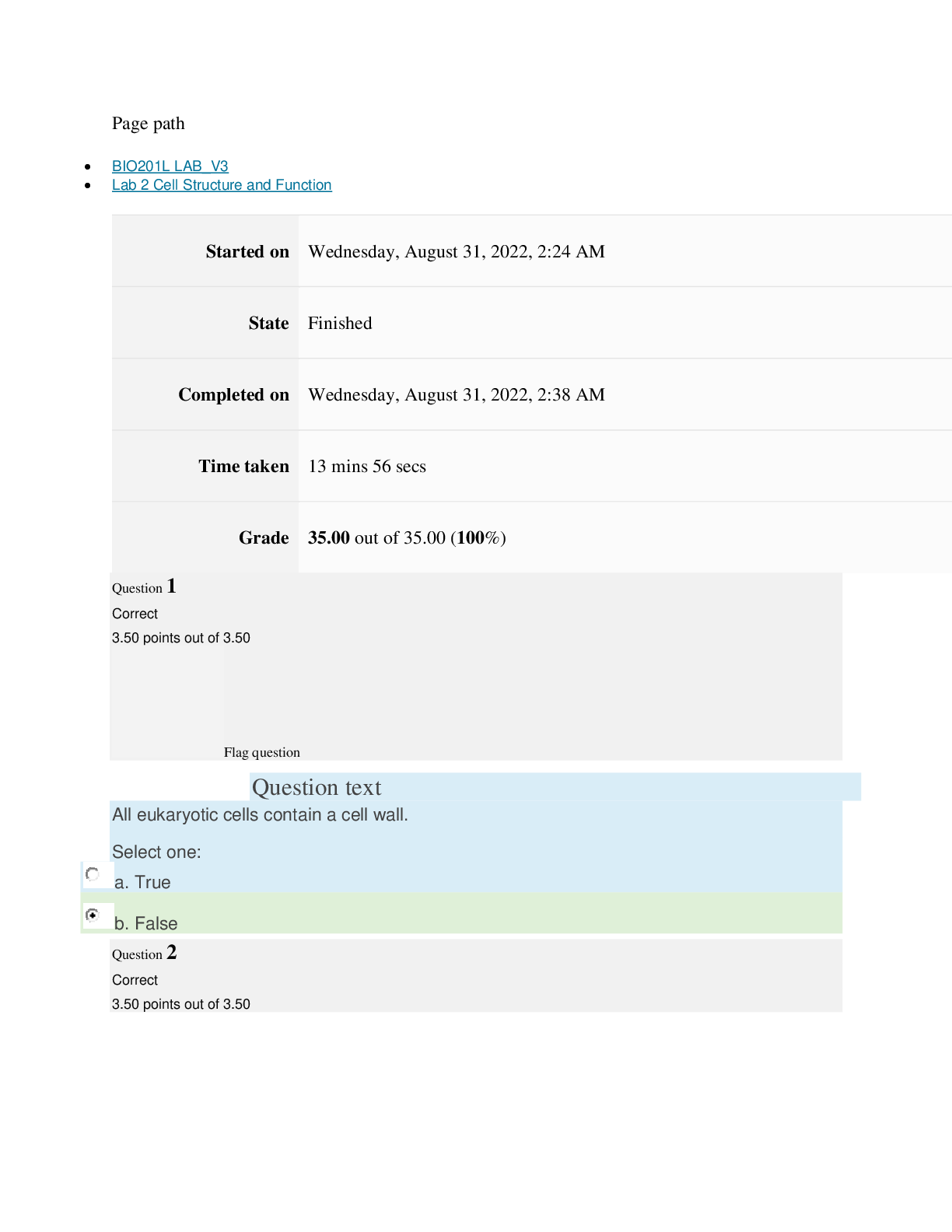

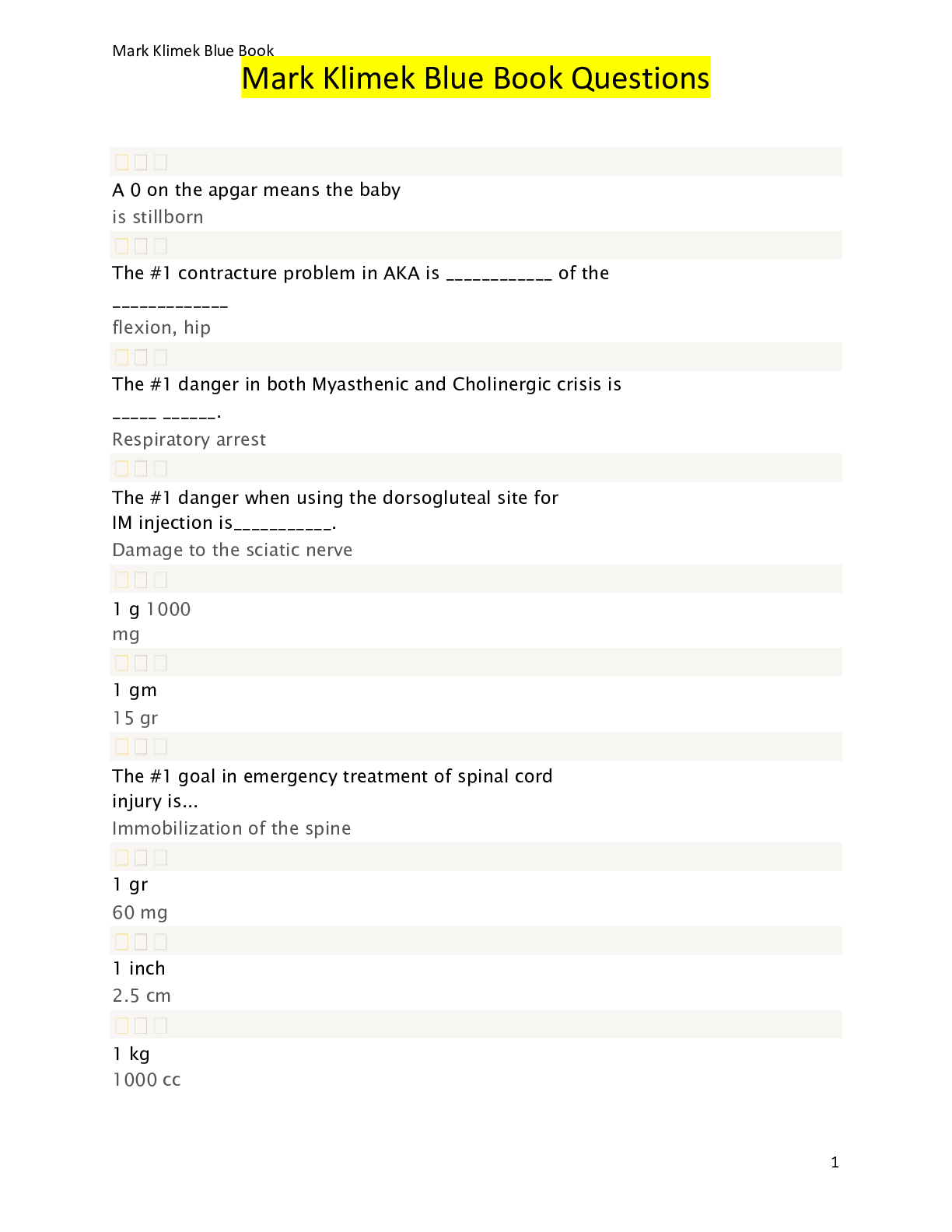

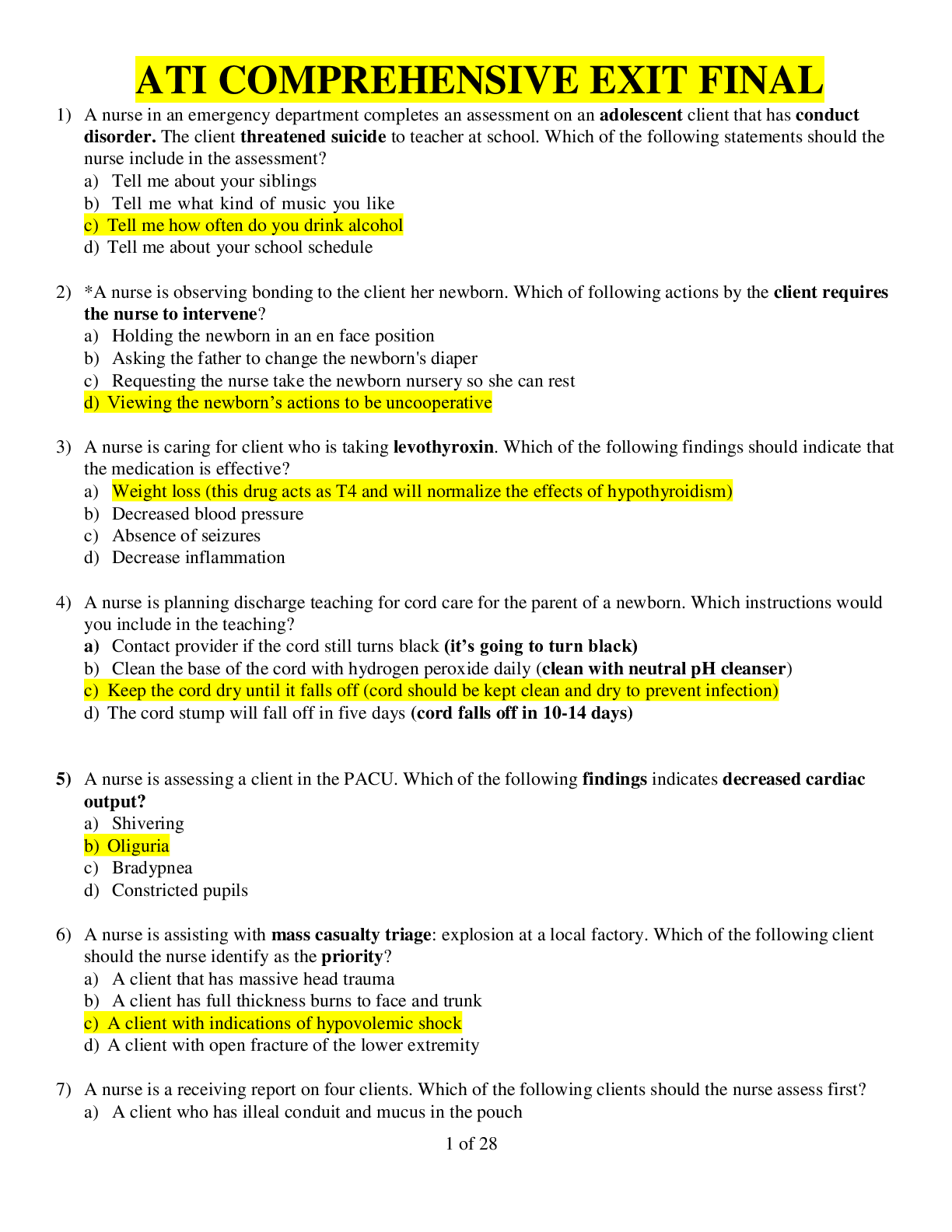



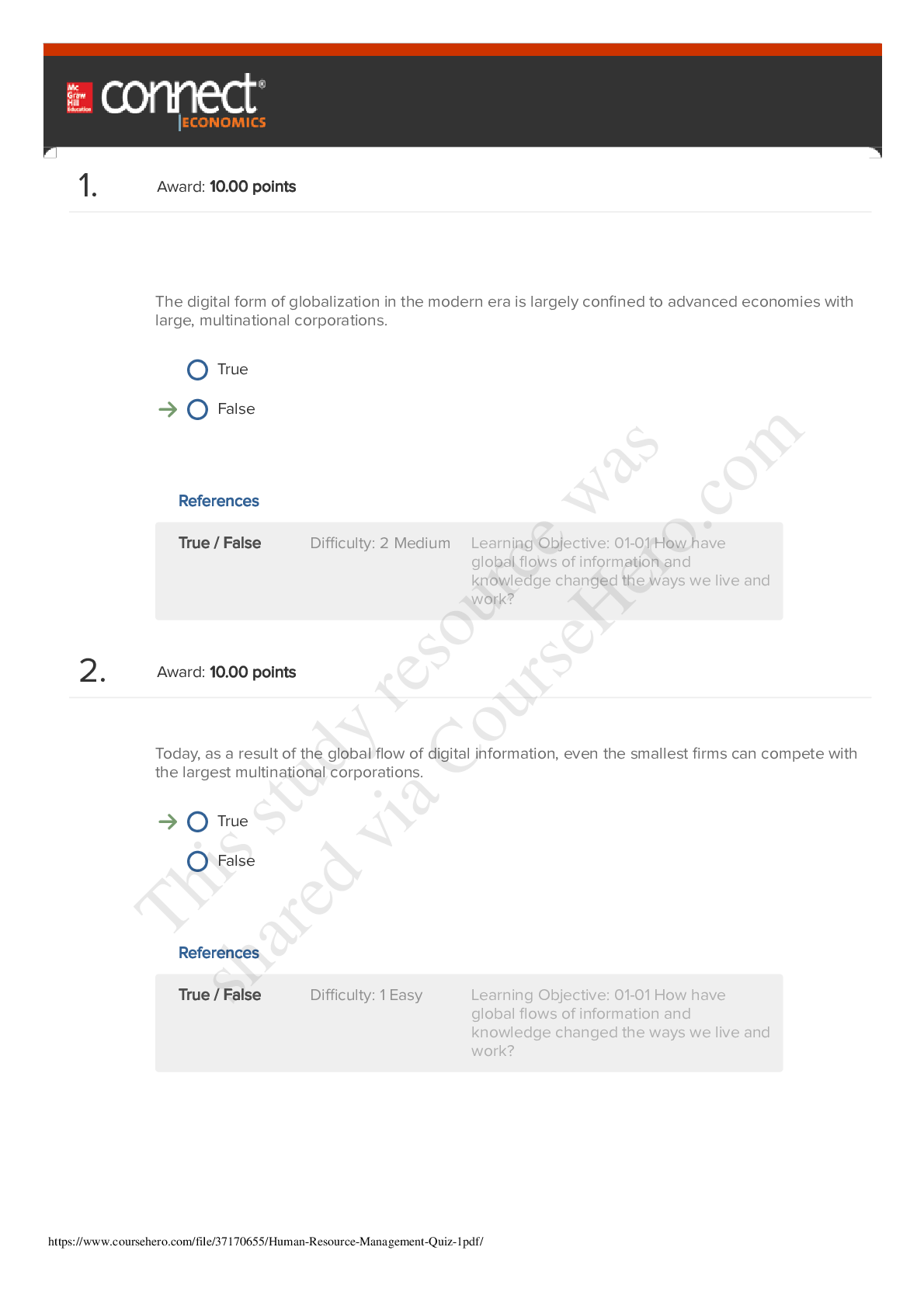
.png)

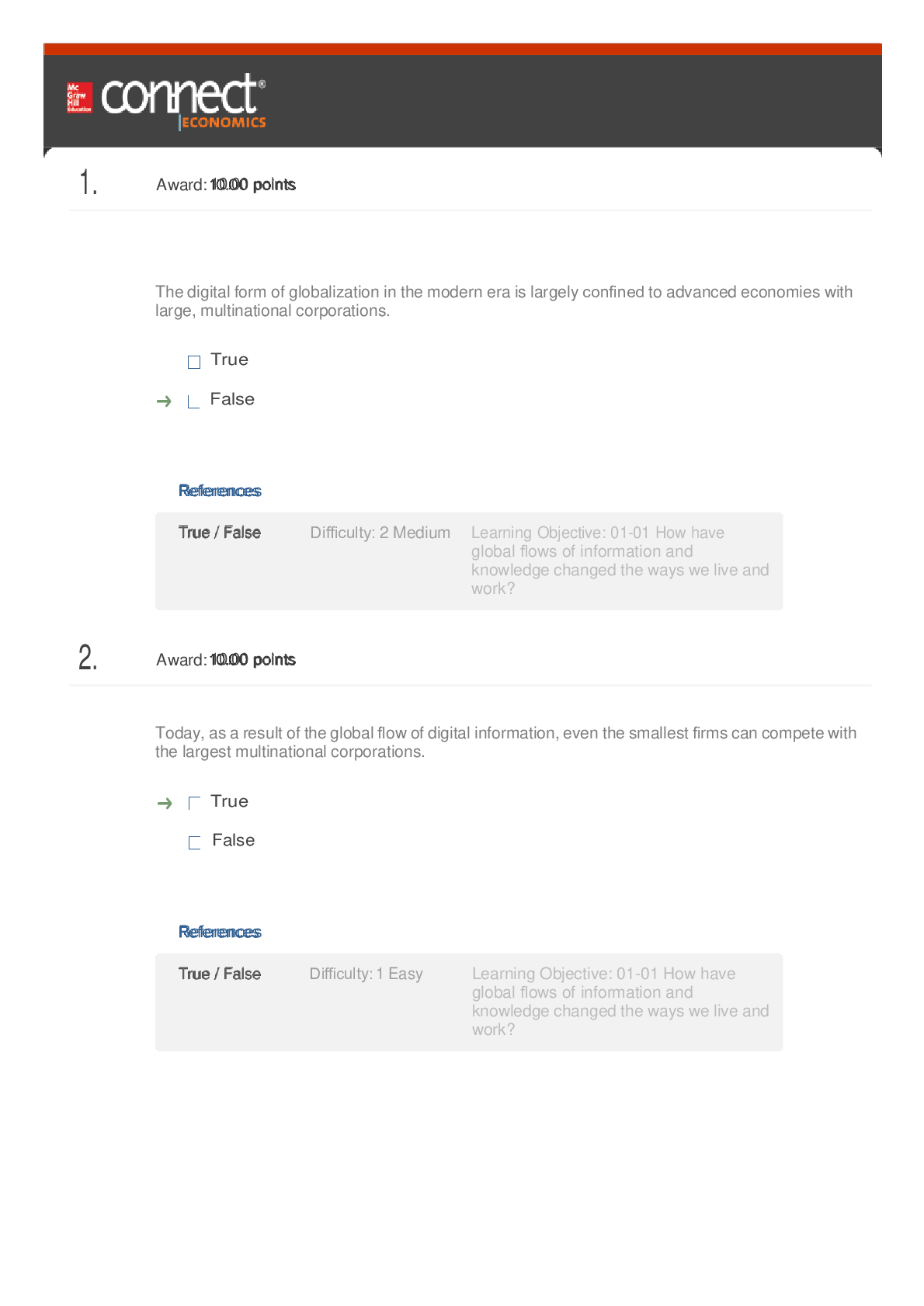

.png)


.png)
